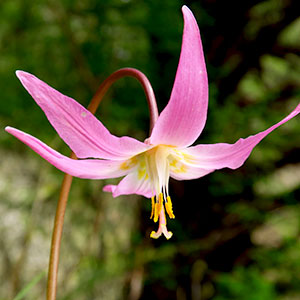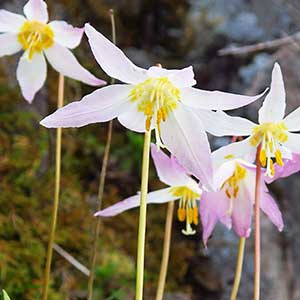Erythronium revolutum
Erythronium elegans
coast fawn lily, mahogany fawn lily, pink fawn-lily
Coast Range fawn lily, elegant fawn-lily
narrowly ovoid, 35–50 mm, sometimes producing sessile offsets.
slender, 30–50 mm.
10–25 mm;
blade distinctly mottled with irregular streaks of brown or white, broadly lanceolate to ovate, margins entire to ± wavy.
7–20 cm;
blade green or faintly mottled with brown or white, narrowly ovate, margins often wavy.
15–40 cm.
10–30 cm.
1–3-flowered.
1–2(–4)-flowered.
tepals uniformly clear violet-pink at anthesis, with yellow banding at base, lanceolate to narrowly elliptic, 25–40 mm, inner with small auricles at base;
stamens ± appressed to style, 12–22 mm;
filaments white to pink (darkening with age), flattened, ± lanceolate, 2–3 mm wide;
anthers bright yellow;
style white to pink, 12–18 mm;
stigma with slender recurved lobes 4–6 mm.
tepals: inner ± white, outer ± white and tinged (often strongly) with pink, especially abaxially and along midline, becoming more generally pinkish with age, both inner and outer with yellow band at base, lanceolate to narrowly elliptic, 20–40 mm, abaxial surfaces and outer tepals often darker, inner auriculate at base;
stamens 13–22 mm;
filaments white, flattened, slightly widened, linear to lanceolate, 0.8–2 mm wide;
anthers yellow;
style white, 10–20 mm;
stigma with slender, usually recurved lobes 2–4 mm.
oblong to obovoid, 3–6 cm.
obovoid to oblong, 2–5 cm.
= 48.
Erythronium revolutum
Erythronium elegans
Of conservation concern.
This species is endemic to the Coast Ranges of western Oregon.
(Discussion copyrighted by Flora of North America; reprinted with permission.)
- Local floras:
BC,
CA,
OR,
WA
- Local Web sites:
CalFlora,
CalPhotos,
Flora NW,
PNW Herbaria,
Turner Photog.
WildflowerSearch
iNaturalist (observations)
USDA Plants Database
- LBJ Wildflower Center
- SEINet
- Plants of the World Online
- Encyclopedia of Life
- Wikipedia
- Google Image Search



